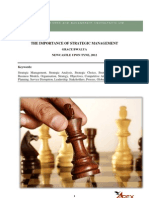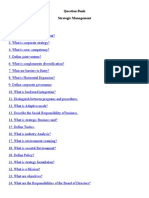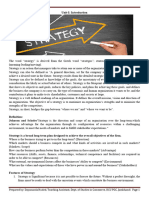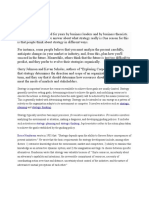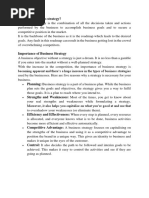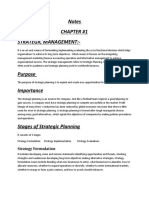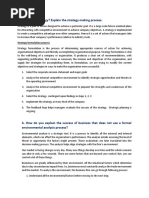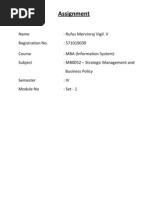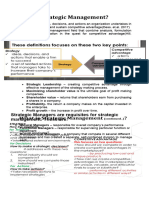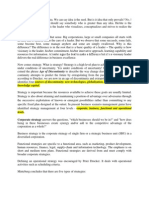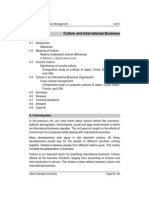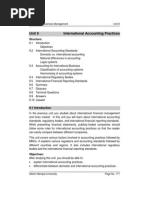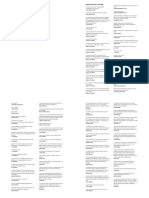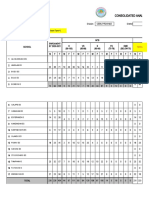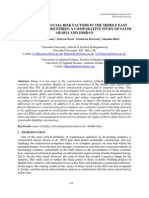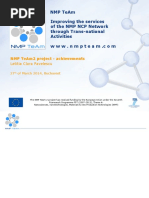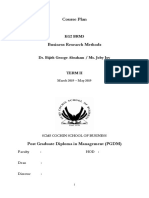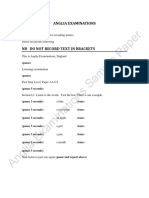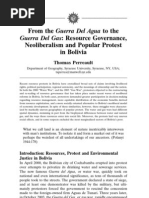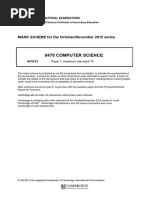MB0053 SLM Unit 11
MB0053 SLM Unit 11
Uploaded by
rajatCopyright:
Available Formats
MB0053 SLM Unit 11
MB0053 SLM Unit 11
Uploaded by
rajatOriginal Description:
Original Title
Copyright
Available Formats
Share this document
Did you find this document useful?
Is this content inappropriate?
Copyright:
Available Formats
MB0053 SLM Unit 11
MB0053 SLM Unit 11
Uploaded by
rajatCopyright:
Available Formats
International Business Management
Unit 11
Unit 11
International Strategic Management
Structure:
11.1 Introduction
Objectives
11.2 Strategic Management
Nature of international strategic management
Advantages and disadvantages of formulating strategy
11.3 Strategic Planning
Types of planning
GAP analysis
Top-down vs. bottom-up planning
11.4 Strategic Management Process
Strategy formulation
Strategic implementation
11.5 Summary
11.6 Glossary
11.7 Terminal Questions
11.8 Answers
11.9 Caselet
11.1 Introduction
In the previous unit, you learned about international marketing and scanning
the market. You also learned about various modes of entry into the
international market. The global marketing strategies were also highlighted
for your understanding. In this unit, we will discuss more about international
strategic management.International strategic management refers to strategy
planning in international business to compete and ensure that they have a
long-term strategy for survival. Strategic management focuses on
developing a strong structure for an organisations business that will
gradually be changed by combining the efforts of each individual that the
organisation employs.
Objectives:
After studying this unit, you should be able to:
explain the nature of international strategic management.
Sikkim Manipal University
Page No. 225
International Business Management
Unit 11
list the advantages and disadvantages of strategy in international
business.
discuss strategic planning and its types.
evaluate the role of strategic management in international business.
describe strategic management process.
11.2 Strategic Management
The nature of strategic management plays a vital role in the international
business world. It is important to understand the term strategic
management before discussing itsnature.
The term strategic management refers to the complete range of strategicdecision making activity in an organisation. Strategic management identifies
and comprehends the environmental factors to control the plans
accordingly. It has evolved as a concept over time and will continue to
evolve.
11.2.1 Nature of international strategic management
Strategic management focuses on the process of formulating, implementing,
and evaluating strategies, to achieve the objectives of an organisation. The
concept of strategic management process in an MNC is similar to that of any
other organisation. However,amajor complicating factor is that before
considering various strategic options, the strategic management process
has to analyse and understand the environmental needs from a regional and
country perspective. Both time and effort is requiredto identify and evaluate
external trends and events in MNCs. Communication between home offices
and overseas operations become complicated because of cultural and
national differences, geographic distances and variations in business
practices. The strategy implementation becomes difficult as different
cultures have different norm values and work ethics.
Strategic management holds significance in international business. An MNC
has to keep track of their various operations in a continuously altering
international environment.
Strategic objectives
Strategic objectives assist in the implementation process of the
organisations objectives or goals. While implementing an international
Sikkim Manipal University
Page No. 226
International Business Management
Unit 11
strategy, an organisation has to identify the opportunities present in these
countries, explore the various resources available, their strengths and
capabilities and plan to work on their core competencies. The objective
should be formed in a way that it is not deficient or immeasurable. The
strategic objectives must help the organisation to achieve their mission and
vision.
Most strategic objectives focus on generatinggreater profits and returns for
the business owners; others focus on customers or society at large. The
strategic objectives(SMART) are as follows:
Specific: A clear message as to what needs to be achieved must be
provided.
Measurable: There must be at least one indicator to measure progress
against fulfilling the objective.
Appropriate: The objectives must be consistent with the given vision
and mission of the organisation.
Realistic: The objectives must be achievable given the organisations
abilities and opportunities in the environment. This means that the
objectives must be challenging and attainable.
Timely: To accomplish the objective there must be a time frame.
Two more aspects have been added to the objectives and it has now
become SMARTER. They are Ethical and Recorded.
When strategic objectives are thoroughly implemented, it will result in
strategic competitiveness that improves the performance and innovation of
these organisations. The advantages of preparing strategic objectives are:
First, they guide employees of an organisation towards achieving the
common goals. This aids the organisation to concentrate and conserve
valuable resources and work together in a timely manner.
Second, challenging objectives encourage and inspire employees to
demonstrate higher levels of commitment and effort. A research has
supported the concept that individuals work harder when they are
motivated towards a specific goal, rather than being asked to simply do
their best.
Third, different parts of an organisation always have the potential to
follow their own goals rather than the overall company goals. Though
the intentions are good, they may work at cross purposes to the
Sikkim Manipal University
Page No. 227
International Business Management
Unit 11
organisation as a whole. Thus, meaningful objectives help resolve
divergence in such instances.
Finally, appropriate objectives offer a standard for rewards and
incentives. They not only result in higher levels of motivation for
employees but they also ensure a greater sense of equalityor fairness
when rewards are allocated.
There are other objectives that are more specific. These are commonly
referred to as short-term objectives that are essential components of action
plans. They play a critical role in implementing an organisations chosen
strategy.
Strategic alliances
In todays trade, the increasing number of strategic alliances stands as one
among the fast growing developments. According to Booz-Allen and
Hamilton,strategic alliances are far-reaching through nearly every industry
and are becoming an important driver of higher growth. Alliances vary in
scope from an informal business association based on a simple contract to
a joint project agreement. To manage the alliance for legal and tax purposes
either a corporation or partnership is set up.
Strategic alliances involve organisations working together towards a
common goal for small businesses, without losing their individuality.
Forming strategic alliances helps one reap considerable profits as well as
obtain rewards of team effort. Statistical studies claim, organisations that
take part in alliances account for 18 percent of their profits that come from
their alliances.
But it is not just profit that encourages the increase in alliances. The other
factors are: a growing intensity of competition, a rising need to operate on a
global scale, a fast varying marketplace, and an industry union in many
markets. Particularly in a time when upcoming international marketing is
becoming the standard, these alliances and partnerships can influence the
growth. Instead of taking the risk and expense that international expansion
requires, any organisation can enter the international market by identifying a
suitable alliance with a business operating in the marketplace that the
organisation wants to enter.
Sikkim Manipal University
Page No. 228
International Business Management
Unit 11
A strategic alliance is basically a partnership in which the organisations
unite by entrusting efforts on a certainproject. The efforts exerted on the
project includegetting a better price for supplies, purchasingbulk products
and building them with each of the organisations that are a part of its
production. The goal of alliances is to reduce risk while increasing the power
and profit. Alliances should not be confused with acquisitions, mergers and
outsourcing. However,there are some similarities in the situation in which a
business may consider one of these solutions. Mergers and acquisitions are
everlasting and determine the survival of the organisation. Outsourcing is
just a way of attaining a functional service for the company.
An alliance is basically a business-to-business partnership. Another term
that is commonly used in combination with alliances is establishing a
business network. Alliances are formed for joint production, design
collaboration, joint marketing, joint sales or distribution, technology
licensing, and research and development. Relationship between a vendor
and a customer is vertical, while the relationship between vendors situated
locally or globally is horizontal. Alliances are established formally in a joint
project or partnership.
Strategic alliances are used in businesses to:
Attain advantages of scope and speed.
Boost market access.
Improve competitiveness in domestic or global markets.
Improve product development.
Increase new business opportunities through new products and
services.
Enlarge market development.
Enhance exports.
Diversify.
Make new businesses.
Minimise costs.
Strategic alliances are becoming a common tool for increasing the reach of
the organisation without exerting organisation to expensive internal
expansions beyond the core business.
Sikkim Manipal University
Page No. 229
International Business Management
Unit 11
11.2.2 Advantages and disadvantages of formulating strategy
The advantages of a well structured strategy in international business are:
It provides proper guidance in business.
It alerts the manager aboutnew opportunities and threats.
It aligns members to work towards common goals that are set.
It facilitates to make management become more proactive than reactive.
It helps the decision making course of assigning resources.
The problems in strategic management are:
As it is tough to predict the future, it becomes difficult to anticipate the
forthcoming environment for developing plans or strategies.
It is expensive to hire an external consultant to develop strategies.It is
prudent to address the immediate crisis before allocating resources (like
opportunity cost, people, money, time) to strategic management
process.
Sometimes few opportunities might be available in firms after
completinga strategic management process. The firm may want to
consider them which becomes difficult then.
Self Assessment Questions 1
1. The nature of ________________ plays a vital role in the international
business world.
2. The strategic objectives should be measurable, appropriate, realistic,
specific, and timely. (True/False)
3. _____________ is a way of attaining a functional service for the
company.
Activity 1
Assume that you own a company that manufacturestoys for the
international market. Your specialty lies in integrating the cultural and
religious aspects into toys. Mention in terms of strategic objectives, how
you would frameyour objectives, and what steps you would take to be
better accepted internationally.
Hint: Identify cultural differences, plan strategy to combat the same and
for alliances.
Sikkim Manipal University
Page No. 230
International Business Management
Unit 11
11.3 Strategic Planning
We had discussed about strategic management in the previous section. In
this section we will learn about the key components of strategic
management that is strategic planning and its types.
Strategic planning involves the structured efforts of an organisation to
effectively recognise its purposes for existing, the direction that the
organisation will pursue, and how that direction will allow the entity to
achieve its short-term and long-term goals. Strategic planning is an
important element in all kinds of organisations and is applied by
governments, non-profit agencies, individuals and businesses.
A simple approach to strategic planning is as discussed below:
1. The first step is to accurately assess where the entity is today, with
respect to its ability and resources.
2. The second step is to recognise where the organisation would like to
reachat some specificpoint of time in the future, by efficiently setting
goals and objectives that it needs to accomplish.
3. The third and final step engages choosing how to successfully progress
from the conditions of today and methodically work toward those goals
in a structured and logical manner.
During the strategic planning process, experts employ many ways, and
sometimes break down each process into a series of steps. The complexity
of the exact approach used frequently comprises of the nature of the
organisation, the kind of goals laid down and the resources needed to attain
those goals.
11.3.1 Types of planning
Strategic planning process involves allocation of resources to firms to fulfil
their long-term goals. Any business plan can be classified into three types.
They are:
Strategic planning: This planning process is the best among the three
business planning processes. It is a long-term process thatthe business
owners utilise to unveil their business vision and mission. It also
determines a gateway for business owners for achieving their goals.
Strategic planning fulfills the mission and the overall goals of the firm.
Whereas, the other two are rather more short-term and are used
Sikkim Manipal University
Page No. 231
International Business Management
Unit 11
sometimes without any relation to the long-term business goals.
However these three kinds of planning work well when used within a
strategic plan.
Intermediate planning: This planning process is for six months to two
years. They outline the manner in which the strategic plan is pursued.
Intermediate plans are often used for campaigns with the purpose and
goal of supporting the trades long-term goals.
Short-term planning: This planning process involves planning for few
weeks or at least for a year. It involvesdetailing out the functioning of a
strategic plan on a daily basis. Resources are allocated for business
management and development that takes place daily within the strategic
plan.
11.3.2 GAP analysis
A GAP analysis is a simple tool that helps the planning team to identify
methods to close the performance gaps. The current affairs and the required
future state must be considered by the planning team. It must be made clear
whether or not the gap can feasibly be closed by the planning team. The
performance gap is closed by modifying resources from activities to be
terminated to activities to be started. If there is uncertainty that the initial gap
cannot be closed, then the feasibility of the required future state must be
reconsidered.
Businesses implementgap analysis to accomplish company-wide goals, or
those for a specific department or area. For example, a firm that wishes to
reduce overhead costs createsa financial gap analysis. Or an organisation
that wants to enlarge its product distribution might come up witha marketing
analysis. Gap analysis help businesses measure their possible profitability
of a goal. This helps the management and staff to understand the plans laid
out in the analysis as well as stay eager about it.
11.3.3 Top-down vs. bottom-up planning
Top-down planning
Top-down planning is a common strategy that is used for project planning. It
helps maintain the decision making process at the senior level. Goals and
allowances are established at the highest level. Senior-level managers have
to be very specific when laying out expectations because the people
following the plan are not involved in the planning process. It is very
Sikkim Manipal University
Page No. 232
International Business Management
Unit 11
important to keep the morale of the employees high and motivate them to
perform the job.Since employees are not included in any of the decision
making processes, they are motivated only through fear or incentives.
Management must choose techniques to align projects and goals with topdown planning. Management alone is held responsible for the plans set and
the end result. The benefit of talented employees with prior experience on
definite aspects of the project are not utilised based on the assumption that
the management can plan and perform a project better without the inputs
from these employees. Some think that the top-down planning process is
the rightway to make a plan, and that the plan development is not important.
It permits the management to segregate a project into steps, and then break
the work into smaller executable parts of the project. Simultaneously, the
work that is broken down is analysed until all the steps could be studied,
due-dates are precisely assigned, and then parts of the project are given to
employees. However, the focus is on long-term goals and the short-term
and uncertain goals can get lost. This approach is best applicable for small
projects.
Bottom-up planning
Bottom-up planning is commonly referred to as tactics. With bottom-up
planning, an organisation gives its project deeper focus because each
organisation has a huge number of employees involved, and each employee
is an expert in their own area. Team members work side-by-side and
contribute during each stage of the process. Plans are developed at the
lowest levels, and then passed on to each of the subsequent higher levels.
Finally, it then reaches the senior management for approval.
Lower-level employees take personal interest in a plan that they are
involved in planning. Employees are more encouraged which in turn
improves their morale. Project managers are responsible for the successful
completion of the project. Let us now consider the key points of top-down
and bottom-up planning.
Top-down planning
Top-down planning helps:
Determine all the goals at the initial stage of the process.
Identify the lack of ground level staff participation.
Estimate the inflexibility.
Sikkim Manipal University
Page No. 233
International Business Management
Unit 11
Find how management imposes the processes.
Determine the lack of motivation.
Find whether the staffs feel that their input is valued or not.
Bottom-up planning
Bottom-up planning helps:
As there are no long term vision here.
Encourage teamwork.
Estimate flexibility.
Determine whether team motivation is of high level.
Identify whether the project is team driven.
Find whether the staff feels valued or not.
Finally, a combination of these two project management methods is most
effective. Using the positive aspects of each, the organisation can align
each step so that the requirements of the project are met. An organisation
can determine the top requirements of the project and allow accountability to
get down with the lower levels. With this combination, the vision of senior
management with the skills of lower level employees is merged. This helps
in completion of the project more efficientlyusing the best employees of the
organisation.
Self Assessment Questions 2
4. A _____________ is a simple tool that helps the planning team identify
methods to close the performance gaps that has been identified.
5. Top-down planning encourages team work. (True/False)
6. ________________ are responsible for the successful completion of
the project.
Activity 2
Assume that you are the manager of an international chemical dyeing
firm that is undergoing a technological change in one of its main units.
How will you implement your strategic planning so that employees
accept and adopt change?
Hint: Use Bottom-up planning.
Sikkim Manipal University
Page No. 234
International Business Management
Unit 11
11.4 Strategic Management Process
In the previous section we learnt about strategic planning and its types. In
this section, we will discuss strategic management process.
Strategic management process is a way businesses build strategies that
help firms respond quickly to the new challenges. This process helps
organisations to find new and more efficient ways to do business.
The organisation should have a good strategic planning that clearly
describes objectives and evaluates both the internal and external situation
to establish the strategy, implement, evaluate, and make necessary
changes to stay as per the vision and mission of the organisation. A pictorial
representation of strategic planning process is shown in figure 10.1.
Figure 10.1: Strategic Management Process
The five levels of strategic management process are:
1. Mission and objectives: The mission defines the organisations
existence. The purpose of the organisation is stated by a mission
statement. The mission statement projects the organisations image to
customers and conveys a purpose to its employees. The goals of the
organisation are called objectives. These objectives are challenging by
nature but achievable. Objectives should be measurable so that the
company can keep a track of its progress and make modifications, if
necessary.
2. Situation analysis: After specifying the objectives, the organisation
must devise a strategic plan to attain them. New opportunities and
methods are adopted to attain the objectives when there are changes
in the external environment. Thereby, an environmental scan is
conducted to find the opportunities. To select opportunities, the
organisation has to know its own abilities and limitations. Situation
analysis includes analysis of both external and internal environment.
The external environment consists of political, social, technological and
other factors. It also analysis the functionality of the organisation. The
internal environment consists of situations like organisational structure,
market share, operational efficiency and others. Situation analysis
Sikkim Manipal University
Page No. 235
International Business Management
Unit 11
provides huge amounts of information. To efficiently manage this
information, the internal factors should be categorised into strengths
and weaknesses of the organisation and external factors should be
categorised into opportunities and threats.
3. Strategy formulation: After having a clear picture of the organisation,
the strategic alternatives are developed. Depending on the
organisations situations, different organisations adopt different
alternatives. Michael Porters identified generic strategies could be
applied to all organisations with
includes cost leadership,
differentiation, cost focus and differentiation focus. All these can be
considered while defining strategic alternatives.
4. Implementation: The strategy is expressed in high-level conceptual
terms. The conceptual terms should be translated into detailed policies
for effective implementation and also for the understanding of the
functional level of the organisation. The functional policies should also
state practical issues clearly. The strategy must be translated into
specific policies for functional areas like marketing, production,
research and development, human resources, information system and
others. The implementation stage also involves finding the required
resources and categorising organisational changes.
5. Evaluation and control:After implementation, the outcome of the
strategy must be measured and evaluated along with the changes that
have been made. To do
this, monitoring control-systems are
developed and implemented. The steps involved in evaluation and
control are to:
1. Describe the parameters to be measured.
2. Describe the target values for those parameters.
3. Carry out measurements.
4. Compare the measured results to the pre-defined standard.
5. Make necessary changes.
11.4.1 Strategy formulation
Strategy formulation is the second phase in the strategic management
process. It is the process of deciding the best course of action for
accomplishing organisational objectives and achieving organisational
purpose.. In fact, objectives and strategies are modified many timesto make
Sikkim Manipal University
Page No. 236
International Business Management
Unit 11
the organisation more successful. This includes creating sustainable
competitive advantages though most of them are swept out gradually by the
competitors efforts.
There are three aspects of strategy formulation. Each aspect has a different
focus that includes requirements to be met within the formulation stage of
strategic management. The three aspects of recommendations must be
internally steady and match together in a jointly supportive manner that
outlines an integrated hierarchy of strategy. The three aspects are:
Corporate level strategy.
Business level strategy or competitive strategy.
Functional strategy.
Corporate level strategy: This aspect of strategy is concerned with the
broads decisions about the total organisation's scope and direction.
Basically, the changes which should be made in the growth objective and
strategy for achieving the objective is considered, the lines of business at
present and how these lines of business go together. The three components
of corporate level strategy are:
Directional or growth strategy: This designs the organisations growth
objective. The objectives range from cutback through stability to altering
levels of growth and how the organisation accomplishes them.
Portfolio strategy: This strategic activity plans the organisations
portfolio in line with those businessess, which needs reconsidering and,
if so, how much concentration or diversification the organisation should
have.
Parenting strategy: This defines the way the organisation assigns
resources and manages abilities and activities across the portfolio,
where to emphasise, and how much the organisation should integrate
into its various lines of business.
Business level strategy orcompetitive strategy: This is also called
business level strategy. It involves deciding how the organisation would
compete within each line of business or strategic business unit.
Functional strategy: Functional strategies are more localised with shorterhorizon activities. They deal with how each functional area and unit
Sikkim Manipal University
Page No. 237
International Business Management
Unit 11
performs its functional activities to be effective and increase resource
productivity.
11.4.2 Strategic implementation
Strategy implementation is one of the stages of strategic management. It
refers to decisions that are made to lay out a new strategy or reinforce
present strategies. The basic activities of strategic implementation are to
establish annual objectives, devise policies and allocate resources. In
addition, strategy implementation also include decision making with respect
to strategy and organisational structure, develop budgets and motivational
systems. The features of strategic implementation are to:
Establish annual objectives.
Devise policies.
Motivate employees.
Allocate resources.
Develop strategy-supportive culture.
Create organisational structure.
Redirect the marketing efforts.
Prepare budgets.
Develop information system.
Activity 3
A firm is in the business of detergent production which caters to the rural
and suburban areas of Uttar Pradesh. Due to the entry of international
players it is facing increasing competition from branded products.After
review meetings, the management decides to concentrate on controlling
costs. It is decided to recast/reengineer the full production and marketing
processes so as to reduce waste. The firm is also planning to to renegotiate with its suppliers s to minimise cost of inputs. There are certain
limittions to cost cutting as the firm cannot compromise on quality and
social issues. Suppliers of inputs are also reluctant to yield to pressures
of renegotiating the cost of raw materials. After some time, sales of the
firm has started declining very fast. What other steps can the
management of the firm plan in order to cope with the growing
competition?
Hint: Read the success story of Ghari Detergent at http://www.businessstandard.com/india/news/watch-out-for-ghari-express/413280/
Sikkim Manipal University
Page No. 238
International Business Management
Unit 11
Self Assessment Questions 3
7. The __________________ process is a way businesses build
strategies that help firms respond quickly to new challenges.
8. The kind of strategy concerned with broad decisions about the total
organisation's scope and direction is _____.
a) Business level strategy
b) Corporate level strategy
c) Functional strategy
d) Competitive strategy
9. One of the phases of strategic management process which includes
decision making with respect to strategy and organisational structure;
develop budgets and motivational systems is _____.
11.5 Summary
Let us summarise the points covered in this unit about international strategic
management:
International strategic management refers to planning the strategy in
international business to compete and also ensure that they have a
long-term strategy for survival.
Strategic management focuses on the process of formulating,
implementing and evaluating strategies to achieve the objectives of an
organisation.
Strategic objectives assist in the implementation process of the
organisations objectives or goals. Most strategic objectives focus on
producing greater profits and returns for the business owners; others
focus on customers or society at large.
Strategic alliances are the means to work together with others towards a
common goal for small businesses without losing their individuality.
Alliances are a way to obtain the rewards of team effort and one can
reap considerable profits from forming strategic alliances.
Strategy in international business has various advantages and
disadvantages.
Strategic planning involves the structured efforts of an organisation to
effectively recognise its purposes for existing, the direction that the
Sikkim Manipal University
Page No. 239
International Business Management
Unit 11
organisation will pursue and how that direction will allow the entity to
achieve its short-term and long-term goals.
The strategic planning process involves allocation of resources to firms
to fulfill their long-term goals. The three types of planning are strategic
planning, intermediate planning and and short term planning.
A GAP analysis is a simple tool that helps the planning team to identify
methods to close performance gaps. Gap analysis help businesses
measure their possible profitability of a goal.
Top-down planning is a common strategy that is used for project
planning. It helps maintain the decision making process at the senior
level. Goals and allowances are established at the highest level.
In bottom-up planning, an organisation gives its project deeper focus
because organisation has a huge number of employees involved and
each employee is an expert in their own area. Team members work
side-by-side and they contribute during each stage of the process.
The concept of strategic management is still evolving and will continue
to undergo changes. Thus, understanding and following the process of
strategic management in international business is helpful to practicing
managers in achieving the organisations' objectives.
11.6 Glossary
Regulatory bodies: These are professional bodies established on the basis
of legal mandate to protect the public.
Uncertainty: It is the situation where the consequences of events are
unpredictable.
MNC: Acronym for multinational company.
Strategy: Plan of action designed to achieve a specific objective.
Alliances: An agreement between two or more entities to achieve a
common goal.
Partnership: An arrangement where individuals agree to cooperate towards
a common goal.
Sikkim Manipal University
Page No. 240
International Business Management
Unit 11
Mergers: Combination of two or more companies, usually by offering the
stockholders of one company securities in the acquiring company for the
surrender of their stock.
Acquisitions: Corporate action in which a company buys most or all the
target company's ownership stakes to assume control of the target firm.
11.7 Terminal Questions
1.
2.
3.
4.
5.
Explain strategic objectives and alliances.
What is strategic planning?
Explain top-down and bottom up planning.
What is Strategic management process?
Explain strategy formulation and implementation.
11.8 Answers
Self Assessment Questions 1
1. Strategic management.
2. True.
3. Outsourcing.
Self Assessment Questions 2
4. GAP analysis.
5. False.
6. Project managers.
Self Assessment Questions 3
7. Strategic management.
8. b) Corporate level strategy.
9. Strategy implementation.
Terminal Questions
1. In order to measure the fulfilment of the objectives, strategic objectives
need to be implemented. Strategic alliances are far-reaching through
nearly every industry. These are explained in sub-section 11.2 of this
unit. Refer the same for details.
2. Strategic planning involves the structured efforts of an organisation to
effectively recognise its purposes for existing, the direction that the
organisation will pursue and how that direction will allow the entity to
Sikkim Manipal University
Page No. 241
International Business Management
Unit 11
achieve its short-term and long-term goals. These are explained in subsection 11.3 of this unit. Refer the same for details.
3. Top-down planning is commonly referred to as strategy. Bottom-up
planning is commonly referred to as tactics. These are explained in subsection 11.3.3 of this unit. Refer the same for details.
4. The strategic management process is a way businesses build strategies
that help the company respond quickly to new challenges. The five
levels of management process are explained in sub-section 11.4 of this
unit. Refer the same for details.
5. Strategy formulation is the second phase in the strategic management
process. Strategy implementation is one of the stages of strategic
management. These are explained in sub-section 11.4.1 and 11.4.2 of
this unit. Refer the same for details.
11.9 Case-let
Magazine Distribution GAP Analysis
Company PQR is the top bio-medical magazine in Pune. The vision of
Company PQR was to be the top distributor throughout India and also
expand their operation abroad. Company PQR initially completed an
analysis showing how it got to be the top regional, then top national
magazine distributor. This includes an overview of every aspect of the
business that contributes to the Company PQR's success, including
marketing, accounting, information technology, management and other
departments.
Company PQR outlined the advantages of achieving its goal of becoming
the top distributor country as well as internationally. Goals were designed
that were specific and measurable. There was a time frame set for
regional supremacy. In this case, Company PQR planned to become the
top nationwide magazine distributor within two years. They achieved their
primary goal of nationwide popularity by bringing innovative schemes that
attracted consumers to buy the same. They brought out an exclusive
section for researchers who were in the field. Company PQR then
researched as to how they would achieve international distributor and
what it requires to do to arrive at this goal. The outcome of Company
PQR's analysis was a complete plan that analysed the competitor
Sikkim Manipal University
Page No. 242
International Business Management
Unit 11
analysis using Porters model as to what they required to do so that they
can see their goal of international distribution. The aim was to achieve
international reach as they co-ordinated with scientists abroad. They
shared information on various aspects of the bio-medical field. There
were many seminars organised and eminent scientists were recognised.
At the next step, they gathered information and conducted GAP analysis
to see where they lacked. The analysis includes a review of competitors,
knowing the needs of the foreign customers, and also interviews with
staff members to know the strengths. After gathering all the information, a
gap analysis report was tabulated.
The report provided a summary of the present situation, the goals the
company wishes to achieve and the steps they had to implement to
achieve these goals. The steps were analysed into strategic planning.
This plan includes detailed action steps of the business for each area, an
agenda to complete each step and a plan that outlines how much the
plan will cost.
The next and final step was for the management to approve and support
the action plan and confirm on the budget. The plan was put into action.
Each step was tracked to assure that the plan stays as per the agenda
and within the allotted budget. The success of the Indian bio-medical
magazine in foreign shores was the talk of the town that year.
Discussion Questions
1. What did the initial analysis include? (Hint: Review of current system)
2. What does the gap analysis report include (Hint: Refer the steps,
summary, plan)
Sources: http://www.wisegeek.com/what-is-gap-analysis.htm retrieved on 15
November 2010
th
References:
K.Aswathappa (2008). International Business. Tata McGraw Hill
Publishing Company Limited.
Geoff Goldman, Cecile Nieuwenhuizen (2006). Strategy: Sustaining
Competitive Advantage in a Globalised Context. Juta and Co.
Mike W Peng (2009), Global Strategic Management, Cengage, London.
Sikkim Manipal University
Page No. 243
International Business Management
Unit 11
Phillippe Lesserre (2007), Global Strategic Management, Palgrave
Macmillan.
Gerardo R Ungson & Yim Yu Wang, (2008), Global Strategic
Management, Library of Congress Cataloging in Publication Data.
Abbass F Alkhafaji, (2003), Strategic Management, Formulation
Implementation in dynamic environment, Haworth Press.
E-Reference:
http://www.smallbusinessnotes.com/operating/leadership/strategi
calliances.html, retrieved on 10th November, 2010
http://www.referenceforbusiness.com/management/Sc-Str/StrategyFormulation.html, retrieved on 5th November, 2010
http://ezinearticles.com/?Types-of-Strategic-PlanningModels&id=4892128, retrieved on 5th November, 2010
http://www.brighthub.com/office/project-management/articles/8542.aspx,
retrieved on 10th November, 2010
http://www.strategicmarketsegmentation.com/strategic-planningprocess-types-and-elements-of-plans/ retrieved on 10th November, 2010
Sikkim Manipal University
Page No. 244
You might also like
- Importance of Strategic Management.Document24 pagesImportance of Strategic Management.Grace Bwalya97% (29)
- MNG3701-exam PrepDocument23 pagesMNG3701-exam PrepKhathutshelo KharivheNo ratings yet
- Strategic Management Q-ADocument96 pagesStrategic Management Q-APratibhaVijaykumarBale50% (2)
- Question Bank Strategic ManagementDocument30 pagesQuestion Bank Strategic ManagementRitz Talent Hub100% (2)
- Unit 1 PDFDocument15 pagesUnit 1 PDFvNo ratings yet
- Developing and Managing A Strategic Marketing Plan Marketing EssayDocument9 pagesDeveloping and Managing A Strategic Marketing Plan Marketing Essayزيد طارق100% (1)
- Management Unit 1Document16 pagesManagement Unit 1amanNo ratings yet
- Strategy - Chapter 1: Study Case of Queen Elizabeth and Lady GagaDocument6 pagesStrategy - Chapter 1: Study Case of Queen Elizabeth and Lady GagaTang WillyNo ratings yet
- Strama AssignmentDocument4 pagesStrama AssignmentMARY JANE CORTEZANo ratings yet
- Strategic Management 2Document46 pagesStrategic Management 2Ritz Talent HubNo ratings yet
- Assignment MB 0052Document4 pagesAssignment MB 0052Katal VSNo ratings yet
- Chapter 1 Over ViewDocument35 pagesChapter 1 Over ViewTeferi GetaNo ratings yet
- Unit I - SMDocument17 pagesUnit I - SMhsurojit546No ratings yet
- Strategic Management MbaDocument56 pagesStrategic Management MbaPooja AkashNo ratings yet
- Topic IiDocument17 pagesTopic IiLianne PadillaNo ratings yet
- Q1. Explain Corporate Strategy in Different Types of OrganizationDocument4 pagesQ1. Explain Corporate Strategy in Different Types of OrganizationPawan KumarNo ratings yet
- 2024 SM NotesDocument61 pages2024 SM NotesANKITA SINGHNo ratings yet
- SMU BBA Semester 2 Spring 2012 Drive Solved AssignmentsDocument8 pagesSMU BBA Semester 2 Spring 2012 Drive Solved AssignmentsRajdeep KumarNo ratings yet
- Answers MA0052Document10 pagesAnswers MA0052piyushwinnNo ratings yet
- Stategic Planning of E-Commerce CompaniesDocument35 pagesStategic Planning of E-Commerce CompaniesangelNo ratings yet
- Strategic Management Full NotesDocument137 pagesStrategic Management Full NotesAnishaAppuNo ratings yet
- Sikkim Manipal University, D EDocument8 pagesSikkim Manipal University, D Epandey_hariom12No ratings yet
- Strategic Management Full NotesDocument145 pagesStrategic Management Full Notesgoforcs100% (2)
- Strategicmanagementfullnotes 110824114832 Phpapp01Document138 pagesStrategicmanagementfullnotes 110824114832 Phpapp01Arun RanaNo ratings yet
- Strategic Competitiveness Is Said To Be Achieved When It Is Successful in TheDocument4 pagesStrategic Competitiveness Is Said To Be Achieved When It Is Successful in TheJessica Paula MiguelNo ratings yet
- SM Chapter 1 NotesDocument6 pagesSM Chapter 1 NotesAnns AhmadNo ratings yet
- Strategic Management Full Notes 1Document137 pagesStrategic Management Full Notes 1ArihantAskiGoswami100% (1)
- Strategic Management Is A Vital Component of Every Successful BusinessDocument4 pagesStrategic Management Is A Vital Component of Every Successful BusinessKareemNo ratings yet
- Strategic Management CHAPTER ONEDocument19 pagesStrategic Management CHAPTER ONEwubeNo ratings yet
- Question/ Answer of Strategic ManagementDocument13 pagesQuestion/ Answer of Strategic ManagementÀmc Chaudhary100% (3)
- Term Paper Principles of Marketing PDFDocument16 pagesTerm Paper Principles of Marketing PDFAkramul HaqueNo ratings yet
- Lec 1,2,3 Chapter Strategic Management EssentialsDocument11 pagesLec 1,2,3 Chapter Strategic Management Essentialshossam.maroafNo ratings yet
- Types of Strategies Long Term ObjectivesDocument25 pagesTypes of Strategies Long Term Objectivesalfi istiqomahNo ratings yet
- BUMA 20023: Strategic Management: Andal, Andrei Feyan P. Bsba HRM 1-1DDocument31 pagesBUMA 20023: Strategic Management: Andal, Andrei Feyan P. Bsba HRM 1-1DCurt Abenoja100% (1)
- Perumusan Dan Implementasi StrategiDocument8 pagesPerumusan Dan Implementasi StrategiHelen PujaNo ratings yet
- Mba 4th Sem Is AssignmentDocument50 pagesMba 4th Sem Is AssignmentRufus Mervinraj VigilNo ratings yet
- Strategic ManagementDocument100 pagesStrategic ManagementRygiem Dela CruzNo ratings yet
- Concept Development: LESSON 1: Introduction To Strategic Business AnalysisDocument24 pagesConcept Development: LESSON 1: Introduction To Strategic Business AnalysisDianna Kate AlbaoNo ratings yet
- Strategic Planning 101Document5 pagesStrategic Planning 101Hafiz ArslanNo ratings yet
- Summary of Chapter 5: Strategies in Action: Long Term ObjectivesDocument14 pagesSummary of Chapter 5: Strategies in Action: Long Term Objectivesnoor74900No ratings yet
- STRAMGTPAPERDocument15 pagesSTRAMGTPAPERJemie UmaliNo ratings yet
- Topic 5 - OverviewDocument25 pagesTopic 5 - Overviewernestkumvenji24No ratings yet
- SM Chapter 1-5Document167 pagesSM Chapter 1-5AlemuNo ratings yet
- 202 Business StrategyDocument8 pages202 Business StrategyShashank PatelNo ratings yet
- 2nd Sem CSDocument65 pages2nd Sem CSArindam PaulNo ratings yet
- Introduction To Strategic Performance ManagementDocument11 pagesIntroduction To Strategic Performance ManagementKelvin MasekoNo ratings yet
- Module 3 SMCGDocument10 pagesModule 3 SMCGRakshith gowda H DNo ratings yet
- Strategic Management Complete NotesDocument233 pagesStrategic Management Complete NotesArunNo ratings yet
- Strategic Management Notes-230Document230 pagesStrategic Management Notes-230Eshu Subramani100% (1)
- Final Gul Ahmed ReportDocument62 pagesFinal Gul Ahmed Reporttaha85khan78% (18)
- What Is Strategic ManagementDocument10 pagesWhat Is Strategic ManagementCASAQUIT, IRA LORAINENo ratings yet
- MS Unit 4 (1)Document24 pagesMS Unit 4 (1)anilkumar.sNo ratings yet
- 402 - SM Full MaterialDocument86 pages402 - SM Full MaterialJ.M Sai TejaNo ratings yet
- Orgnization and ManagementDocument7 pagesOrgnization and ManagementAngelo DonatoNo ratings yet
- Bps Neo Lesson 2Document13 pagesBps Neo Lesson 2jaydee magalangNo ratings yet
- Knowledge Capital.: Corporate Strategy Answers The Questions, "Which Businesses Should We Be In?" and "How DoesDocument9 pagesKnowledge Capital.: Corporate Strategy Answers The Questions, "Which Businesses Should We Be In?" and "How DoeskushwahavkNo ratings yet
- Unit1 Strategic ManagementDocument15 pagesUnit1 Strategic Managementpuskarcing16No ratings yet
- Translating Strategy into Shareholder Value: A Company-Wide Approach to Value CreationFrom EverandTranslating Strategy into Shareholder Value: A Company-Wide Approach to Value CreationNo ratings yet
- Unit 2 International Trade Theories & Their Application: StructureDocument21 pagesUnit 2 International Trade Theories & Their Application: StructurerajatNo ratings yet
- Unit 3 International Business Environment: StructureDocument23 pagesUnit 3 International Business Environment: StructurerajatNo ratings yet
- Unit 4 Culture and International Business: StructureDocument21 pagesUnit 4 Culture and International Business: Structurerajat100% (3)
- Unit 8 International Financial Management: StructureDocument19 pagesUnit 8 International Financial Management: StructurerajatNo ratings yet
- Unit 9 International Accounting Practices: StructureDocument21 pagesUnit 9 International Accounting Practices: StructurerajatNo ratings yet
- Unit 12 Ethics in International Business: StructureDocument22 pagesUnit 12 Ethics in International Business: StructurerajatNo ratings yet
- Unit 13 International Human Resource Management: StructureDocument26 pagesUnit 13 International Human Resource Management: StructurerajatNo ratings yet
- Unit 14 Finance and International Trade: StructureDocument23 pagesUnit 14 Finance and International Trade: StructurerajatNo ratings yet
- Sociology FinalDocument92 pagesSociology Finalbrockz26No ratings yet
- Dictums BookletDocument2 pagesDictums BookletKhalid Ali Saif Al-ShamsiNo ratings yet
- 93 42 EEC ChecklistDocument15 pages93 42 EEC ChecklistdulichsinhthaiNo ratings yet
- q4 Qra Form 5 Gr.1 10 ModifiedDocument159 pagesq4 Qra Form 5 Gr.1 10 ModifiedMarilyn BrigoliNo ratings yet
- The 24-Hour ClockDocument5 pagesThe 24-Hour ClockCervoiseNo ratings yet
- Civil Engineering and Environmental ScienceDocument2 pagesCivil Engineering and Environmental ScienceJustine Ryan L. MalgapoNo ratings yet
- Stainless EnstainlessDocument27 pagesStainless EnstainlessVinaya Almane DattathreyaNo ratings yet
- Windows Memory ManagementDocument11 pagesWindows Memory ManagementbetahitaNo ratings yet
- History of Math StuffDocument5 pagesHistory of Math StuffaemNo ratings yet
- Ready Set Leap Ebook 3Document20 pagesReady Set Leap Ebook 3Rosa FerreiraNo ratings yet
- Addressing Crucial Risk Factors in The Middle East Construction IndustriesDocument11 pagesAddressing Crucial Risk Factors in The Middle East Construction Industriessadiqaftab786No ratings yet
- Worm and Worm WheelDocument1 pageWorm and Worm WheelAnkit PariharNo ratings yet
- NMP Team Improving The Services of The NMP NCP Network Through Trans-National ActivitiesDocument19 pagesNMP Team Improving The Services of The NMP NCP Network Through Trans-National ActivitiesAlexandra DumitrescuNo ratings yet
- Increasing and Decreasing Functions, Concavity and Inflection PointsDocument17 pagesIncreasing and Decreasing Functions, Concavity and Inflection PointsAnonymous Gd16J3n7No ratings yet
- 2 Management TheoriesDocument54 pages2 Management TheoriesMelih KutluNo ratings yet
- Business Research MethodsDocument9 pagesBusiness Research MethodsArputha RajNo ratings yet
- Classroom Observation Assignment-Form 2 Omer DoganDocument3 pagesClassroom Observation Assignment-Form 2 Omer Doganapi-317051668No ratings yet
- Brief About ISO 45001 vs. OHSAS 18001Document1 pageBrief About ISO 45001 vs. OHSAS 18001bhavesh sangtaniNo ratings yet
- Sample Paper: Anglia ExaminationsDocument2 pagesSample Paper: Anglia ExaminationsOmar AminNo ratings yet
- IZMX16,40Document97 pagesIZMX16,40Daniel EneaNo ratings yet
- Perrault - Guerra Del Agua y Gas BoliviaDocument23 pagesPerrault - Guerra Del Agua y Gas BoliviaAlejandro DiazNo ratings yet
- Focus On Vocabulary 2 Chp3and4Document3 pagesFocus On Vocabulary 2 Chp3and4Rao Mn AKhiNo ratings yet
- Doing Literary Criticism PDFDocument253 pagesDoing Literary Criticism PDFAbegale SotoNo ratings yet
- 01 Kpi Individual - Staff Ga - M Rajib - (Juli - September)Document7 pages01 Kpi Individual - Staff Ga - M Rajib - (Juli - September)Polaris YudaNo ratings yet
- 1.ISO9001-2008-QMS-Introductory & Awareness Training Course OutlineDocument2 pages1.ISO9001-2008-QMS-Introductory & Awareness Training Course OutlineeddiekuangNo ratings yet
- KoehlerDocument232 pagesKoehlerl0k0tusNo ratings yet
- HeheDocument28 pagesHeheRCOANo ratings yet
- Dallmayr, Comparative Political Theory What Is It, and What Is It Good For PDFDocument21 pagesDallmayr, Comparative Political Theory What Is It, and What Is It Good For PDFsubscribed14No ratings yet
- Computer Science Mark SchemeDocument9 pagesComputer Science Mark SchemeDivij AhujaNo ratings yet
- Extinción VicariaDocument10 pagesExtinción VicariaAlba ArmeroNo ratings yet

